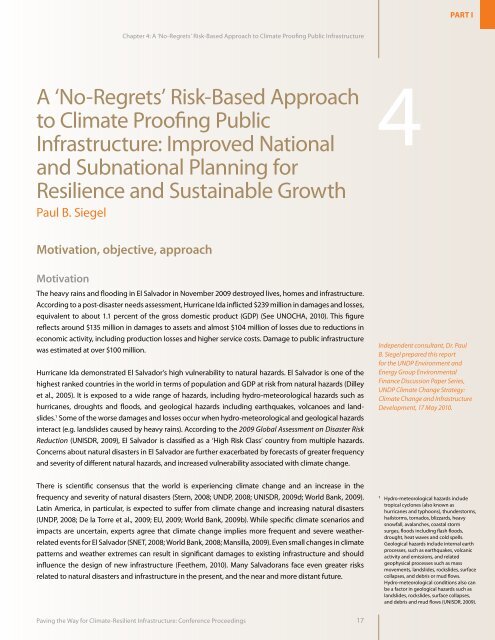Paving the Way for Climate-Resilient Infrastructure - UN CC:Learn
Paving the Way for Climate-Resilient Infrastructure - UN CC:Learn
Paving the Way for Climate-Resilient Infrastructure - UN CC:Learn
You also want an ePaper? Increase the reach of your titles
YUMPU automatically turns print PDFs into web optimized ePapers that Google loves.
PART IChapter 4: A ‘No-Regrets’ Risk-Based Approach to <strong>Climate</strong> Proofing Public <strong>Infrastructure</strong>A ‘No-Regrets’ Risk-Based Approachto <strong>Climate</strong> Proofing Public<strong>Infrastructure</strong>: Improved Nationaland Subnational Planning <strong>for</strong>Resilience and Sustainable GrowthPaul B. Siegel4Motivation, objective, approachMotivationThe heavy rains and flooding in El Salvador in November 2009 destroyed lives, homes and infrastructure.According to a post-disaster needs assessment, Hurricane Ida inflicted $239 million in damages and losses,equivalent to about 1.1 percent of <strong>the</strong> gross domestic product (GDP) (See <strong>UN</strong>OCHA, 2010). This figurereflects around $135 million in damages to assets and almost $104 million of losses due to reductions ineconomic activity, including production losses and higher service costs. Damage to public infrastructurewas estimated at over $100 million.Hurricane Ida demonstrated El Salvador’s high vulnerability to natural hazards. El Salvador is one of <strong>the</strong>highest ranked countries in <strong>the</strong> world in terms of population and GDP at risk from natural hazards (Dilleyet al., 2005). It is exposed to a wide range of hazards, including hydro-meteorological hazards such ashurricanes, droughts and floods, and geological hazards including earthquakes, volcanoes and landslides.1 Some of <strong>the</strong> worse damages and losses occur when hydro-meteorological and geological hazardsinteract (e.g. landslides caused by heavy rains). According to <strong>the</strong> 2009 Global Assessment on Disaster RiskReduction (<strong>UN</strong>ISDR, 2009), El Salvador is classified as a ‘High Risk Class’ country from multiple hazards.Concerns about natural disasters in El Salvador are fur<strong>the</strong>r exacerbated by <strong>for</strong>ecasts of greater frequencyand severity of different natural hazards, and increased vulnerability associated with climate change.Independent consultant, Dr. PaulB. Siegel prepared this report<strong>for</strong> <strong>the</strong> <strong>UN</strong>DP Environment andEnergy Group EnvironmentalFinance Discussion Paper Series,<strong>UN</strong>DP <strong>Climate</strong> Change Strategy:<strong>Climate</strong> Change and <strong>Infrastructure</strong>Development, 17 May 2010.There is scientific consensus that <strong>the</strong> world is experiencing climate change and an increase in <strong>the</strong>frequency and severity of natural disasters (Stern, 2008; <strong>UN</strong>DP, 2008; <strong>UN</strong>ISDR, 2009d; World Bank, 2009).Latin America, in particular, is expected to suffer from climate change and increasing natural disasters(<strong>UN</strong>DP, 2008; De la Torre et al., 2009; EU, 2009; World Bank, 2009b). While specific climate scenarios andimpacts are uncertain, experts agree that climate change implies more frequent and severe wea<strong>the</strong>rrelatedevents <strong>for</strong> El Salvador (SNET, 2008; World Bank, 2008; Mansilla, 2009). Even small changes in climatepatterns and wea<strong>the</strong>r extremes can result in significant damages to existing infrastructure and shouldinfluence <strong>the</strong> design of new infrastructure (Fee<strong>the</strong>m, 2010). Many Salvadorans face even greater risksrelated to natural disasters and infrastructure in <strong>the</strong> present, and <strong>the</strong> near and more distant future.1Hydro-meteorological hazards includetropical cyclones (also known ashurricanes and typhoons), thunderstorms,hailstorms, tornados, blizzards, heavysnowfall, avalanches, coastal stormsurges, floods including flash floods,drought, heat waves and cold spells.Geological hazards include internal earthprocesses, such as earthquakes, volcanicactivity and emissions, and relatedgeophysical processes such as massmovements, landslides, rockslides, surfacecollapses, and debris or mud flows.Hydro-meteorological conditions also canbe a factor in geological hazards such aslandslides, rockslides, surface collapses,and debris and mud flows (<strong>UN</strong>ISDR, 2009).<strong>Paving</strong> <strong>the</strong> <strong>Way</strong> <strong>for</strong> <strong>Climate</strong>-<strong>Resilient</strong> <strong>Infrastructure</strong>: Conference Proceedings 17
















